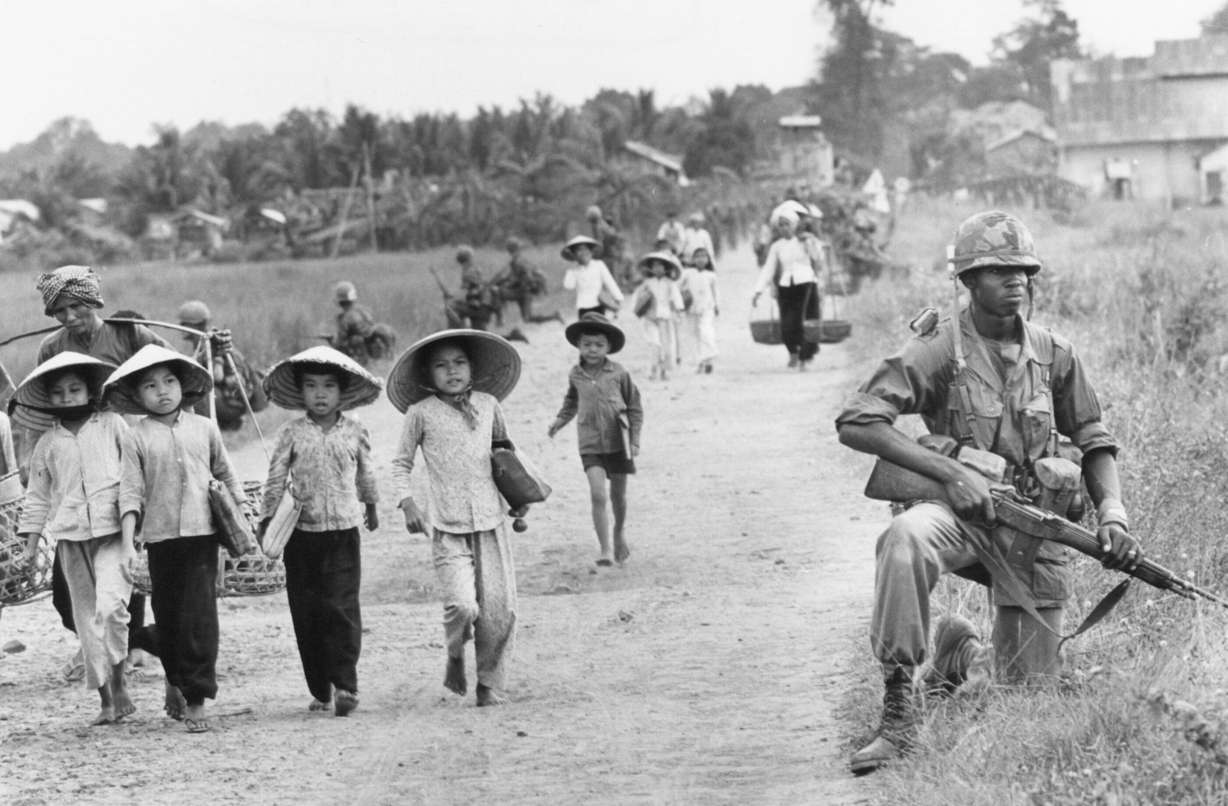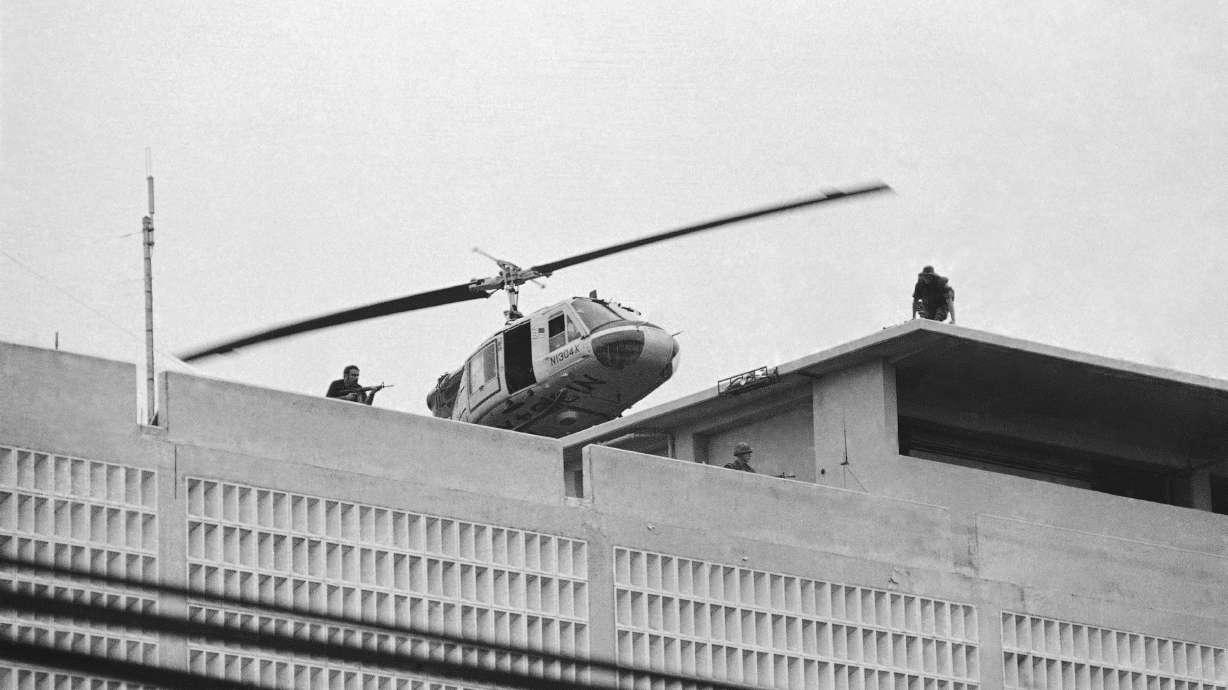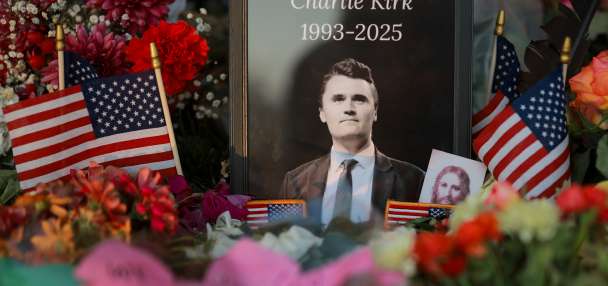Estimated read time: 7-8 minutes
- Naja Pham Lockwood fled Vietnam on the last ship as Saigon fell. She was 7 years old.
- Lockwood, now in Utah, reflects on her journey from refugee to American that began 50 years ago.
- Her documentary explores Vietnam War trauma, aiming for reconciliation and understanding.
SALT LAKE CITY — Naja Pham Lockwood sat in a corner of the last South Vietnamese ship to leave Vietnam during the harrowing chaos as Saigon fell to the North Vietnamese.
As a multitude of people crowded aboard on April 28, 1975, the smell of sweat from their bodies nauseated and suffocated the almost-7-year-old girl. She saw mothers running with a child under one arm and a bag containing all their worldly possessions under the other. She heard the sounds and screams of desperate people pushing and shoving their way onto the single plank leading to the ship. Some tossed their young children onto the bow, knowing they would never see them again.

Lockwood, her parents and younger brother and sister, maternal grandparents, and an uncle and his family had waited until the last minute to flee the war-ravaged country. Her dad, a history professor and lawyer who had worked with the U.S. Agency for International Development, wanted to stay, but his father urged him to leave for the sake of his family. He could have been sent to prison or executed because of his association with the Americans.
They almost didn't make it out.
Engine failure kept the ship from moving as bombs exploded around Saigon. It finally left port early on April 30, 1975, the day the North Vietnamese captured the capital of South Vietnam, ending the Vietnam War. The collapse of the South Vietnamese government led to the unification of Vietnam under communist control.
Wednesday, April 30, marked the 50th anniversary of the Fall of Saigon.
"It's hard to believe I've been in this country for 50 years," Lockwood said.
The anniversary, she said, is a good time to reflect on the journey of refugees, like the Vietnamese, becoming new Americans.

"It just really shows that refugees and immigrants are part of the fabric of what makes America. It is the fabric of America. Refugees do make America great," Lockwood said.
"I don't identify as a Vietnamese. I am an American with Vietnamese roots. I feel as though this is my home. I don't think of Vietnam as my home," she said.
'Saigon Execution'
Now living in Park City, Lockwood, 57, and her husband, David, are the parents of three adult children. A graduate of Boston University and Harvard Business School, she is a jewelry designer, investor and film producer. She was the executive producer of "Last Days in Vietnam," an Academy Award-nominated documentary that premiered at the Sundance Film Festival in 2014.
Lockwood is currently crisscrossing the country to screen her latest project, "On Healing Lands, Birds Chirp," a short documentary exploring the lasting trauma of the Vietnam War. The film, directed by Lockwood, features interviews with the people connected to the iconic photo "Saigon Execution."
On Feb. 1, 1968, Associated Press photographer Eddie Adams captured the national police chief of South Vietnam, Brig. Gen. Nguyen Ngoc Loan, shooting Nguyen Van Lem, a Vietcong officer, in the head point-blank, two days after the Tet Offensive. Lem was believed to have murdered the wife and six children of one of Loan's deputies. A seventh child survived.
Lockwood first saw the horrific image on television as a 7-year-old girl living in Worcester, Massachusetts, where her family had settled. It gave her nightmares for weeks. She kept the light on in her bedroom and the bathroom at night. Her father would come into her room to tell her stories about the boy who survived and how, like her, he was now growing up in America.
"That photo was always in my mind all throughout my life. I thought about the victims involved. I thought about the story behind Eddie Adams' photo," Lockwood said. "That photo haunted me as a child, and I wanted to just make peace with that photo by telling the story."
Reconciliation and healing
Lockwood's documentary includes interviews with June Nguyen, Loan's daughter, Huan Nguyen, the boy who survived the family massacre, and Thong and Loan Nguyen, the children of Nguyen Van Lem, the Viet Cong officer executed in the photograph.
The goal of the film, she said, is not to revisit old wounds or further sensationalize the iconic photo, which became a symbol for the anti-war movement and a catalyst for the U.S. withdrawal from Vietnam.

Lockwood said it came from a desire to explore the multifaceted human stories behind the image and to provide a more nuanced understanding of the context surrounding the event and its aftermath. Its limited perspective left significant aspects of the story untold. The film seeks to address that gap by giving voice to the children directly affected by the incident and by highlighting the broader themes of moving toward healing, reconciliation and understanding that transcend individual experiences, she said.
"You can see that at the end of the day, all sides have horrific trauma from the war — whether you're an American, a Vietnamese from the South, or the Vietnamese of communism. I just think, at the end, no one wins in war. That's really what I wanted to show," Lockwood said.
Huan Nguyen, the surviving boy Lockwood's father told her had come to the United States, became the first Vietnamese-American promoted to rear admiral in the U.S. Navy.
"I think that is beautiful, in terms of the journey of refugees, to become new Americans and to see that in his life," she said, adding he showed resilience and channeled his pain and trauma to serve as a protector of his adopted country. "We as refugees and immigrants do contribute to this society and this country that we love dearly called America."
My parents really felt like Americans. They never felt this was not their home. We knew we were never going back to Vietnam as a home. I feel as American as anyone else on July Fourth.
–Naja Pham Lockwood
All-American family
As the refugee ship Lockwood and her family were on reached international waters 50 years ago, the crew took down the South Vietnamese flag and raised the American flag.
"I just remember people crying. I just remember the adults just not wailing but standing there with tears because they sang, I think, for the very last time, the South Vietnamese anthem as the flag was taken down," she said. "I'll always remember that. I just saw my parents crying."

The ship sailed to Guam for processing. From there, the family made its way to Worcester with sponsorship from the Catholic Church. The neighborhood embraced the only Asians on the street immediately.
"I really felt my town had these amazing core values," Lockwood said, adding the kids were third-generation Italian and Irish immigrants. "They revered the pope, God and the Kennedys."
On her family's first Thanksgiving, neighbors came to their home with all the traditional foods, from a turkey to cranberry sauce. Mothers came to her school at lunch and recess to teach her English. Weekends were family time with baseball and softball on Saturdays and Sundays reserved for mass. Nuns and priests became her second set of parents. In high school, teachers suggested colleges and wrote recommendation letters for her. She played on the tennis team where the coach was a Vietnam vet who wore his green military jacket to meets. She had an all-American upbringing in many ways.
"The community really supported us, and it made all the difference for us as family," Lockwood said, referencing a Harvard study that found the first three years of how people treat refugees or immigrants makes all the difference in their sense of belonging and who they are.
"My parents really felt like Americans. They never felt this was not their home. We knew we were never going back to Vietnam as a home. I feel as American as anyone else on July Fourth."

Love and compassion
Lockwood is active in Utah's refugee resettlement community and has worked closely with government agencies and other organizations. The state, she said, has a thoughtful, consistent approach that is a model for how refugees and immigrants should be treated. Utahns work together regardless of political persuasion to welcome people in all the right ways, she said.
The community really supported us, and it made all the difference for us as family.
–Naja Pham Lockwood
"We, as children of God, have a duty to treat all people with love and compassion. That's so vital and needed," she said.
Lockwood is the founder of RYSE Media Ventures, which supports stories of diverse voices, and is an investor in Impact Partners Films, which has financed "Won't You Be My Neighbor?" a 2018 documentary about the life of Fred Rogers, the host and creator of "Mister Rogers Neighborhood." It's a reminder of how human beings should treat each other on a daily basis.
Said Lockwood, "We need more of Mr. Rogers in this world right now."









